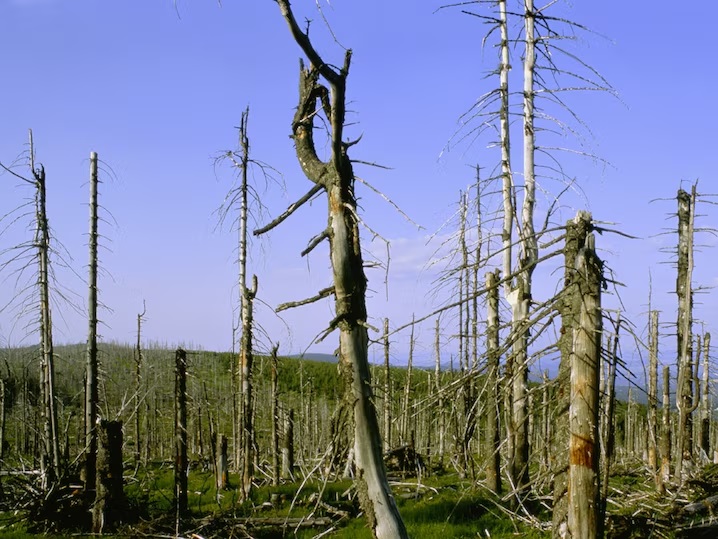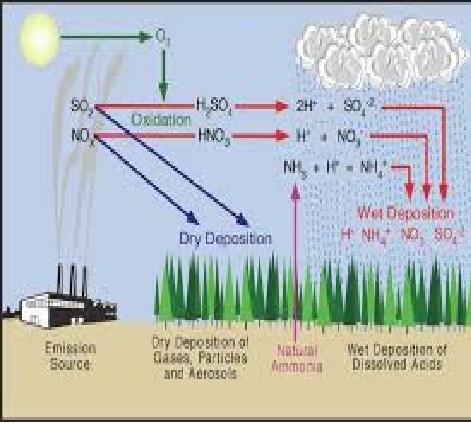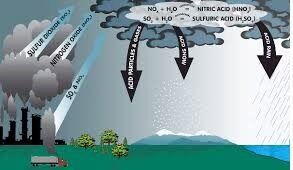When acid forming primary pollutants like SO2, H2S and NOx move through atmosphere, they encounter a number of solid particles and water vapour moving in air. Some of those pollutants combine with water vapour to form secondary pollutants like acids of sulphur and nitrogen that fall down as acid rain. This is called as wet deposition of acids.
When acid forming pollutants are absorbed by solid particles like fly ash etc. already present as pollutants in the atmosphere, this process is called as dry deposition of acids. In fact, dry deposition refers to acidic gases absorbed by particles that move through wind here and there.
The acids absorbed by solid particles in air are also washed down to earth during rains; otherwise, they remain in the atmosphere for longer periods. In this way the concentration of acids in rain water is increased. These processes wet and dry deposition of acids in the environment are together called as Acid Deposition in the Environment. The acid rain is only a part of acid deposition.
Impact of Acid Rain
The acid rain affects living and non- living components of environment. In July 1982, Stockholm- the venue of U N –conference on acid rain, suffered heavy acid showers for about a week. In India too, acid rains have been reported since last twenty years in areas where thermal power plants are located and also around Delhi, the capital of India.
Some of the remarkable impacts of acid rain are mentioned below-
A. Impacts on Human Health: Acids of rain water join food-chains and water cycles and reach to human body systems. There they cause various types of health problems like neurological and digestive disorders, problems of eyes, throat and respiratory tract. Acid rain causes varieties of safety hazards like reduced visibility due to smog etc.
B. Impact on Flora and Fauna: Acid rain has seriously adverse impacts on aquatic as well as terrestrial flora and fauna. It kills fishes in lakes and ponds.
Sweden and U.S.A. have 15000 and 100 fishless lakes respectively due to acid rains. About 237 lakes in Adirondack have highly acidic water with pH below 5. Numerous species of microorganisms are also killed due to acid rains.

About 10 percent of forests have been destroyed and 18 million acres of vegetation are under serious threat due to acid rains in West Germany. Acid reaches to wild animals through water cycle and food- chains and cause serious health problems often leading to death.
Acidic water containing traces of toxic metals destroys root systems of plants. Since acid rain is a transboundary problem, both Norway and Sweden experience up to 90 percent acid rain due to air pollution in United Kingdom.

Acid deposition in soil damages trees like Pine, Cedar, Ashes, Birch, and Spruce etc. About 5000 sq km of Cedar trees in Japan have already been damaged by acid rains. The populations of phytoplankton, snails, insects etc. are eliminated due to acid rains.
C. Impact of Acid Rain on Monuments: Acid is corrosive by nature. Hence, water containing acids will also be naturally corrosive. Even dry acids deposited in air causes damage to limestone, marble and metals. Acid rain causes heavy damage to monuments and other buildings containing limestone, marble and metals as acids quickly react with these substances. Some chemical reactions of Sulphuric acid with different substances are given below.
CaSO4 + H2SO4 CaSO4 + H2O + CO2
Marble
Cu + H2SO4 CuSO4 + H2 Copper
Zn + H2SO4 ZnSO4 + H2
The damage caused to rocks and marble by acid rain is called as marble-leprosy or stone- leprosy. In India acid rain was reported to cause damage to the walls of Taj Mahal in Agra.
Acid rain has caused serious damages to different things and statues in the world like monuments and statues in Italy and Greece etc. St. Paul’s Cathedral in Bristol is being corroded by acid rains. The British environment experiences acidic snow fall. Much of the snow that falls there contains acids due to which the snow does not melt easily.
Prevention and Control of Acid Rain
Acid rain can be prevented by controlling air pollution especially from industrial sources. For this, industrial units should install such technological equipments or devices that may control emissions at the source of their origin.
Scrubbers, filters and electrostatic precipitators are some devices that help in controlling as well as removing air pollutants. Acidic water should be neutralized chemically so as to reduce its toxicity.
The existing level of air pollutants especially CO2, SO2, NO, NO2, N2O etc. should gradually be removed out of atmosphere through specific technology. Vehicles should also be fitted with pollution control devices. They must be checked regularly for their exhausts.




